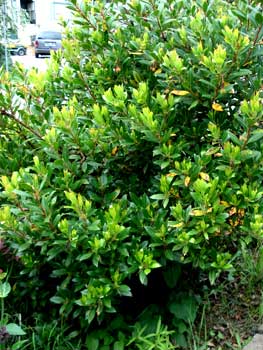
Strawberry Tree
"They set great store by their gardens. In them they have vineyards, all manner of fruit, herbs, & flowers, so pleasant, so well furnished & so finely kept, that I never saw thing more fruitful, nor better trimmed in any place."
-Utopia
by Sir Thomas More
(1478-1535)
by Sir Thomas More
(1478-1535)
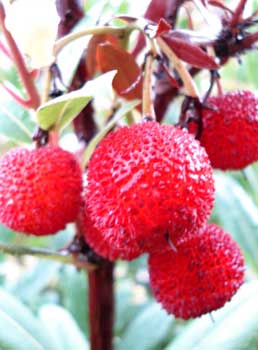 The strawberry tree (Arbutus unedo) is a small broadleaf evergreen tree or large shrub with a spreading round shape, typically with three or more trunks though it can be trained as a single-trunked upright tree of narrower habit.
The strawberry tree (Arbutus unedo) is a small broadleaf evergreen tree or large shrub with a spreading round shape, typically with three or more trunks though it can be trained as a single-trunked upright tree of narrower habit.It is capable of growing twenty feet high, rarely thirty, & will be just about as wide as it is tall. But in Northwest gardens it tends to stay a good deal smaller, in the eight to twelve foot range, & slow reaching that.
A mature specimen has gnarly limbs & reddish cracked bark of considerable rustic beauty. Only the thickest central trunk & largest branches show the craggy bark. The tannin-rich bark was traditionally used by leather tanners.
Ours was installed a few years ago at five feet tall, & not at the time very bushy. It has not gotten a great deal taller in the three or four years since, but it's bushed outward a lot, despite some pruning to encourage more upward growth instead of girth.
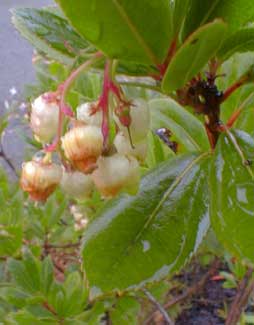 The laurel-like evergreen leaves have red veins when young, & the leaf stems are red. Charming clusters of pink-flushed white honey-scented bellflowers resemble the blooms of blueberries or manzanitas. The flowers appear by mid-October & deep into winter.
The laurel-like evergreen leaves have red veins when young, & the leaf stems are red. Charming clusters of pink-flushed white honey-scented bellflowers resemble the blooms of blueberries or manzanitas. The flowers appear by mid-October & deep into winter.Being self-fertile, it sets round fruit in winter, which very slowly ripen from green to yellow to pink to red & are bumply or warted. The fruits take a full year to ripen, so that this evergreen will have new flowers & ripening fruits simultaneously.
The fruits don't really look like strawberries because they're perfectly round, but the size & color is otherwise pretty close, hence the tree's name. The flesh is amber & has a texture similar to strawberries except mealy. These fruits are edible but insipid so rarely eaten raw, though birds like them, & frankly so do I. I eat tons of them when at long, long last they ripen. Though the fruits cling unripe for just about a full year, but when finally bright red, they'll drop off rather soon if not harvested.
The species name "unedo" means "I eat one," with the implication that few people would bother to eat a second one. I don't know why I find them so likeable, but I suspect more people would love them if they weren't so startled that a fruit is no sweeter than a vegetable. Give me a party-tray with an array of veggies -- say, celery & carrot sticks, broccoli flowers, & strawberry tree fruits -- I'll eat the round red fruits first. I also frequently startle squirrels when I go to pluck a handful of these berries, as the squirrels like them too.
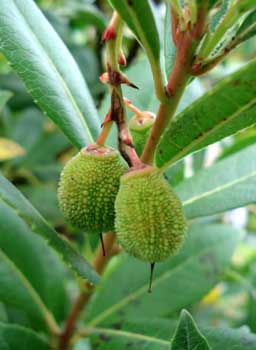 Some people report that the fruits they've tried were sweet & pleasant, but "sweet" is just the wrong expectation, unless they really do get sweeter on the branches in hotter regions than ours. But even for folks who demand a sweeter fruit & find this one too neutral-flavored to their liking, it nevertheless is worthy of harvest for use or preserves or mixed with sweeter fruits for canning.
Some people report that the fruits they've tried were sweet & pleasant, but "sweet" is just the wrong expectation, unless they really do get sweeter on the branches in hotter regions than ours. But even for folks who demand a sweeter fruit & find this one too neutral-flavored to their liking, it nevertheless is worthy of harvest for use or preserves or mixed with sweeter fruits for canning.Many a fruit that seems bland raw becomes extremely flavorful when fermented (wintergreen springs to mind). The strawberry tree's fruit is very commonly used to make fermented aromatic drinks such as Medronho or Medronheira in Portugal, Tsipuoro in Greece, Fior de Corbezzolo in Sicily, Creme d'Arbouse in Corsica, & other beverages. It may not taste like a sugar-rich fruit, but it does have a fairly high sucrose content, so the fruits can ferment right on the tree, & birds, or people, eating the fermented berries can become intoxicated.
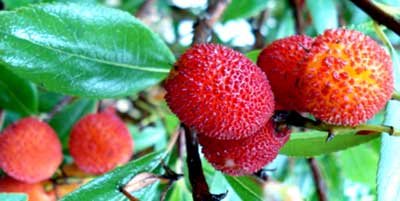 In a heavy fruiting year considerable mess can be made on a sidewalk or patio, which should be considered when placing the tree.
In a heavy fruiting year considerable mess can be made on a sidewalk or patio, which should be considered when placing the tree.Ours is by the sidewalk but drops its fruit on ground only so not a nuisance as yet; it might be so when it's a good deal larger if/when it begins to overhang the sidewalk. With luck birds & squirrels take care of it before the sidewalk gets sticky with fruit & needs a hard spraying.
Hardy for zones 7 through 10, the strawberry Tree is native to Turkey, Lebanon, much of southern Europe, & surprisingly Ireland, where it is believed to be a pre-Ice Age relic. It is closely related to the madrona (A. menziesii) native to our local environs of the Pacific Northwest, a large brittle tree with gorgeous red-brown peeling bark.
Strawberry trees like most any soil condition in full sun. They produce a long taproot so cannot be transplanted once they are established, but thanks to that taperoot they eventually become extremely drought hardy. They require no fertilizing & very little in the way of irrigation, for which reason they are sometimes used in "parking lot gardens."
They have a naturally formal rounded shape & require no pruning, either, unless a specimen is to be trained as a single-trunked tree, which will require annual attention spring and/or autumn, to restrict its desire to be multi-trunked & very wide.